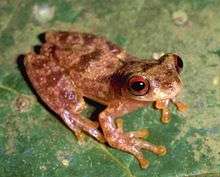Dendropsophus joannae
Dendropsophus joannae is a species of frogs in the family Hylidae. It is known from the Pando Department, northern Bolivia (where its type locality is), western Brazil (Acre and Amazonas states), and Madre de Dios Region of southeastern Peru.[2] It is similar to Dendropsophus leali but is smaller, has a shorter snout, more protuberant eyes, and more tuberculate dorsal skin.[3][4] The specific name joannae honors Mrs. Jo Ann Oxley Foster, a BIOPAT patron supporting taxonomic research and nature conservation.[3][5]
| Dendropsophus joannae | |
|---|---|
 | |
| Scientific classification | |
| Kingdom: | Animalia |
| Phylum: | Chordata |
| Class: | Amphibia |
| Order: | Anura |
| Family: | Hylidae |
| Genus: | Dendropsophus |
| Species: | D. joannae |
| Binomial name | |
| Dendropsophus joannae (Köhler and Lötters, 2001) | |
| Synonyms[2] | |
|
Hyla joannae Köhler and Lötters, 2001[3] | |
Description
Adult males measure 15–19 mm (0.6–0.7 in) and adult females, based on two specimens only, 20–21 mm (0.8–0.8 in) in snout–vent length. The body is slender. The snout is rounded. The tympanum is distinct with prominent annulus; the supratympanic fold is evident. The fingers and the toes are short and bear large discs; the fingers are about two-fifth webbed while the toes are about four-fifth webbed. The dorsum is grayish or yellowish tan with brown markings. The finger and toe discs are dorsally bright yellow. The ventral surfaces of limbs and belly are fleshy transparent. The chest is cream and the throat is yellowish. The inner iris is red, surrounded by narrow tan ring.[3]
Habitat and conservation
Dendropsophus joannae has been found in open habitats with tall grass surrounding small ponds and roadside ditches[1] at elevations of 238–250 m (781–820 ft) above sea level.[1][6] Breeding presumably takes place in ponds and ditches.[1] It appears to be an adaptable species and is considered not to likely to be facing major threats.[1] It occurs in a number of protected areas in Brazil.[4]
References
- Reichle, S.; De la Riva, I. & Köhler, J. (2004). "Dendropsophus joannae". IUCN Red List of Threatened Species. 2004: e.T55521A11324594. doi:10.2305/IUCN.UK.2004.RLTS.T55521A11324594.en. Retrieved 26 May 2020.
- Frost, Darrel R. (2020). "Dendropsophus joannae (Köhler and Lötters, 2001)". Amphibian Species of the World: an Online Reference. Version 6.1. American Museum of Natural History. doi:10.5531/db.vz.0001. Retrieved 26 May 2020.
- Köhler, Jörn & Lötters, Stefan (2010). "A new species of minute Hyla from the southwestern Amazon Basin (Amphibia, Anura, Hylidae)". Studies on Neotropical Fauna and Environment. 36 (2): 105–112. doi:10.1076/snfe.36.2.105.2135.
- Melo-Sampaio, Paulo Roberto & De Souza, Moisés Barbosa (2015). "New and noteworthy distributional records of treefrogs (Anura) from southwestern Amazonia" (PDF). Check List. 11 (4): 1681. doi:10.15560/11.4.1681.
- Beolens, Bo; Watkins, Michael & Grayson, Michael (2013). The Eponym Dictionary of Amphibians. Pelagic Publishing. p. 103. ISBN 978-1-907807-42-8.
- Barrio-Amorós, C. L. & Neira, D. R. (2004). "Geographic distribution: Hyla joannae" (PDF). Herpetological Review. 35 (4): 404.
